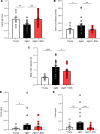Purine nucleoside phosphorylase inhibition ameliorates age-associated lower urinary tract dysfunctions
- PMID: 32910805
- PMCID: PMC7605521
- DOI: 10.1172/jci.insight.140109
Purine nucleoside phosphorylase inhibition ameliorates age-associated lower urinary tract dysfunctions
Abstract
In the aging population, lower urinary tract (LUT) dysfunction is common and often leads to storage and voiding difficulties classified into overlapping symptom syndromes. Despite prevalence and consequences of these syndromes, LUT disorders continue to be undertreated simply because there are few therapeutic options. LUT function and structure were assessed in aged (>25 months) male and female Fischer 344 rats randomized to oral treatment with a purine nucleoside phosphorylase (PNPase inhibitor) 8-aminoguanine (8-AG) or vehicle for 6 weeks. The bladders of aged rats exhibited multiple abnormalities: tactile insensitivity, vascular remodeling, reduced collagen-fiber tortuosity, increased bladder stiffness, abnormal smooth muscle morphology, swelling of mitochondria, and increases in urodamaging purine metabolites. Treatment of aged rats with 8-AG restored all evaluated histological, ultrastructural, and physiological abnormalities toward that of a younger state. 8-AG is an effective treatment that ameliorates key age-related structural and physiologic bladder abnormalities. Because PNPase inhibition blocks metabolism of inosine to hypoxanthine and guanosine to guanine, likely uroprotective effects of 8-AG are mediated by increased bladder levels of uroprotective inosine and guanosine and reductions in urodamaging hypoxanthine and xanthine. These findings demonstrate that 8-AG has translational potential for treating age-associated LUT dysfunctions and resultant syndromes in humans.
Keywords: Aging; Cellular senescence.
Conflict of interest statement
Figures









Similar articles
-
Purine nucleoside phosphorylase as a target to treat age-associated lower urinary tract dysfunction.Nat Rev Urol. 2022 Nov;19(11):681-687. doi: 10.1038/s41585-022-00642-w. Epub 2022 Sep 7. Nat Rev Urol. 2022. PMID: 36071153 Free PMC article. Review.
-
A uro-protective agent with restorative actions on urethral and striated muscle morphology.World J Urol. 2021 Jul;39(7):2685-2690. doi: 10.1007/s00345-020-03492-6. Epub 2020 Oct 19. World J Urol. 2021. PMID: 33078215 Free PMC article.
-
Dysregulated Purine Metabolism Contributes to Age-Associated Lower Urinary Tract Dysfunctions.Adv Geriatr Med Res. 2021;3(4):e210018. doi: 10.20900/agmr20210018. Epub 2021 Sep 29. Adv Geriatr Med Res. 2021. PMID: 34676378 Free PMC article.
-
Purine nucleoside phosphorylase inhibition is an effective approach for the treatment of chemical hemorrhagic cystitis.JCI Insight. 2024 Mar 8;9(5):e176103. doi: 10.1172/jci.insight.176103. JCI Insight. 2024. PMID: 38271096 Free PMC article.
-
8-Aminopurines in the Cardiovascular and Renal Systems and Beyond.Hypertension. 2023 Nov;80(11):2265-2279. doi: 10.1161/HYPERTENSIONAHA.123.20582. Epub 2023 Jul 28. Hypertension. 2023. PMID: 37503660 Free PMC article. Review.
Cited by
-
8-Aminoinosine and 8-Aminohypoxanthine Inhibit Purine Nucleoside Phosphorylase and Exert Diuretic and Natriuretic Activity.J Pharmacol Exp Ther. 2022 Aug;382(2):135-148. doi: 10.1124/jpet.122.001221. Epub 2022 May 24. J Pharmacol Exp Ther. 2022. PMID: 35609923 Free PMC article.
-
8-Aminopurines: A Promising New Direction for Purine-Based Therapeutics.Hypertension. 2024 Dec;81(12):2410-2414. doi: 10.1161/HYPERTENSIONAHA.124.21726. Epub 2024 Oct 21. Hypertension. 2024. PMID: 39429198
-
Effect of Collagen Fiber Tortuosity Distribution on the Mechanical Response of Arterial Tissues.J Biomech Eng. 2025 Feb 1;147(2):021004. doi: 10.1115/1.4067152. J Biomech Eng. 2025. PMID: 39545747
-
Purine nucleoside phosphorylase as a target for the treatment of interstitial cystitis/bladder pain syndrome with and without Hunner lesions.Sci Rep. 2024 Sep 19;14(1):21898. doi: 10.1038/s41598-024-73280-4. Sci Rep. 2024. PMID: 39300176 Free PMC article.
-
Purine nucleoside phosphorylase as a target to treat age-associated lower urinary tract dysfunction.Nat Rev Urol. 2022 Nov;19(11):681-687. doi: 10.1038/s41585-022-00642-w. Epub 2022 Sep 7. Nat Rev Urol. 2022. PMID: 36071153 Free PMC article. Review.
References
-
- Dubeau CE. The aging lower urinary tract. J Urol. 2006;175(3 Pt 2):S11–S15. - PubMed
Publication types
MeSH terms
Substances
Grants and funding
LinkOut - more resources
Full Text Sources
Medical

